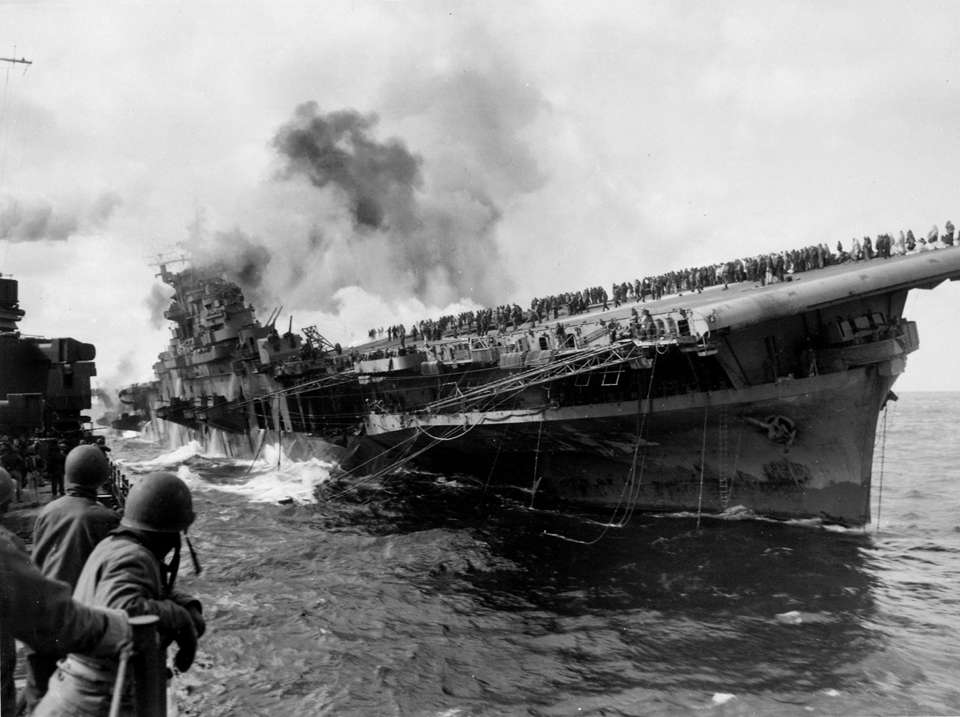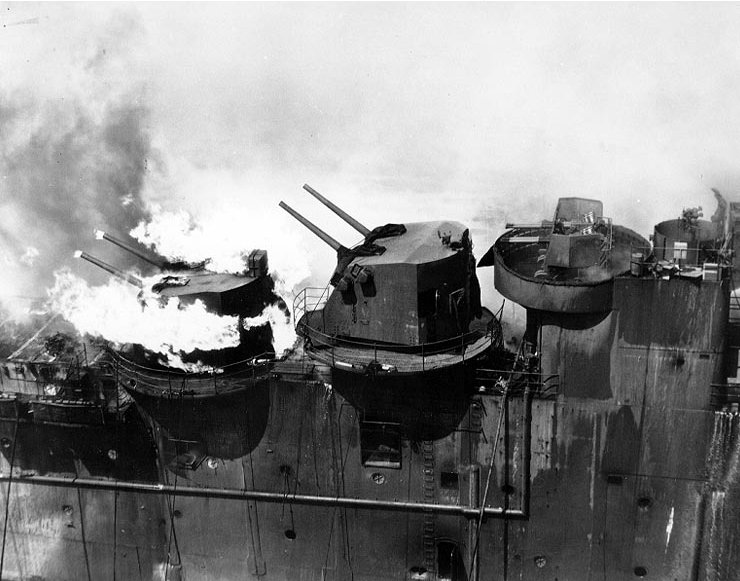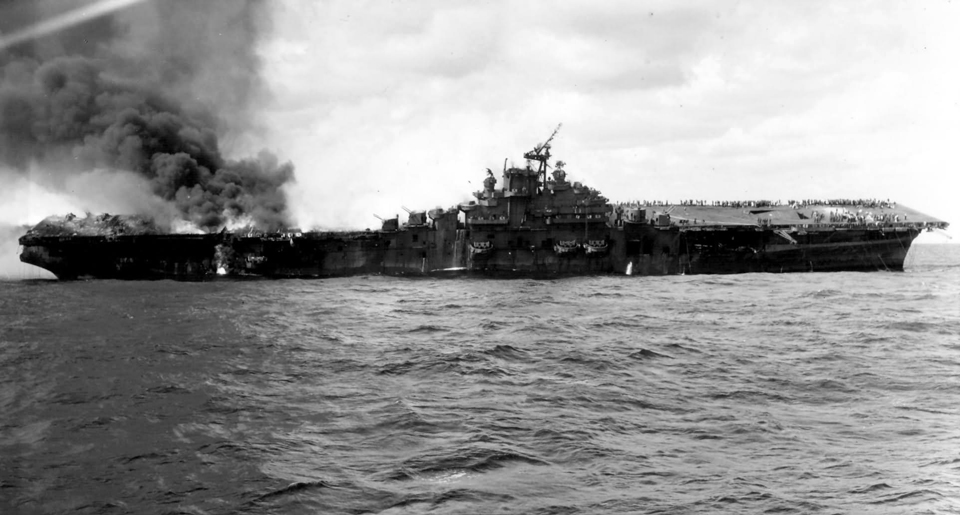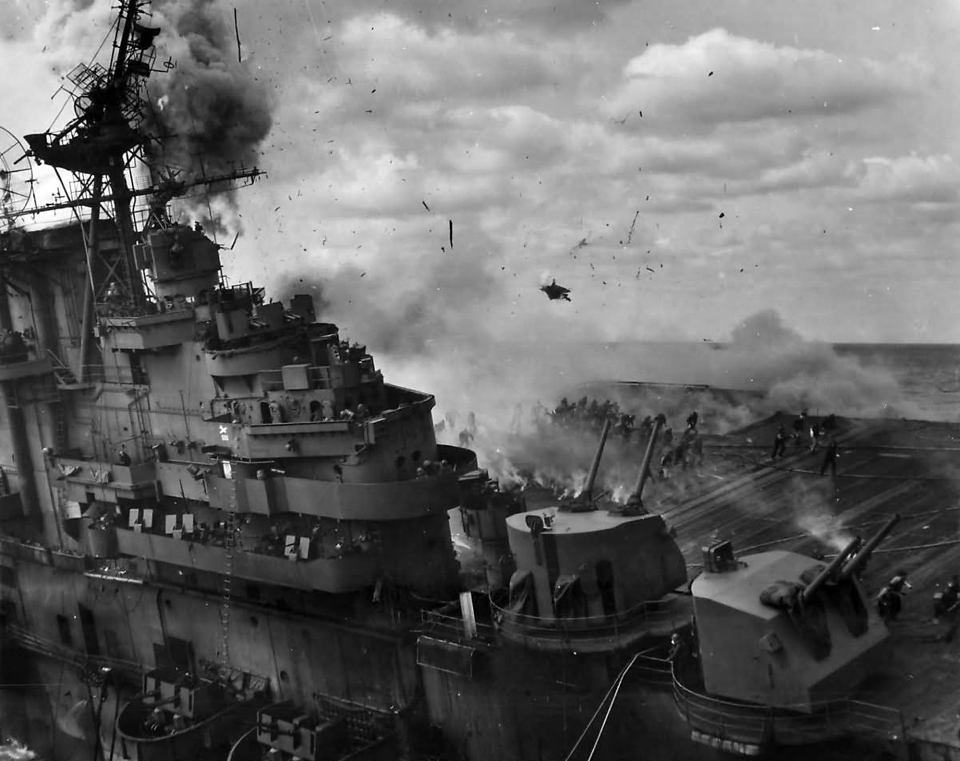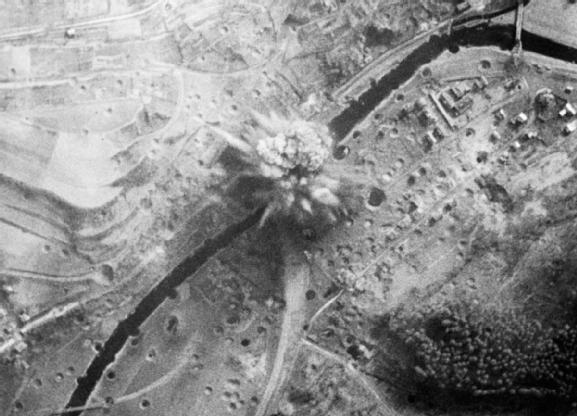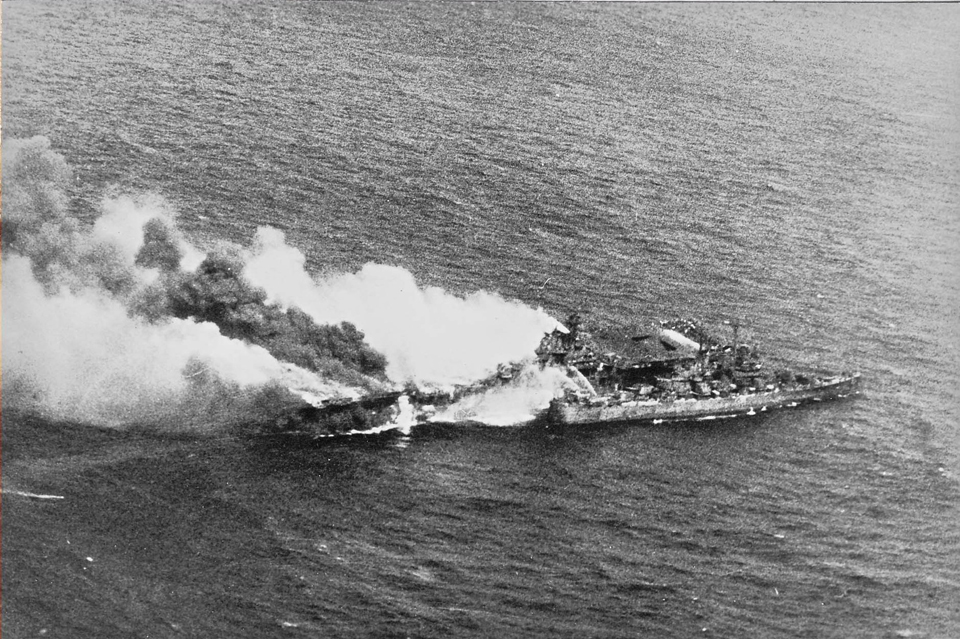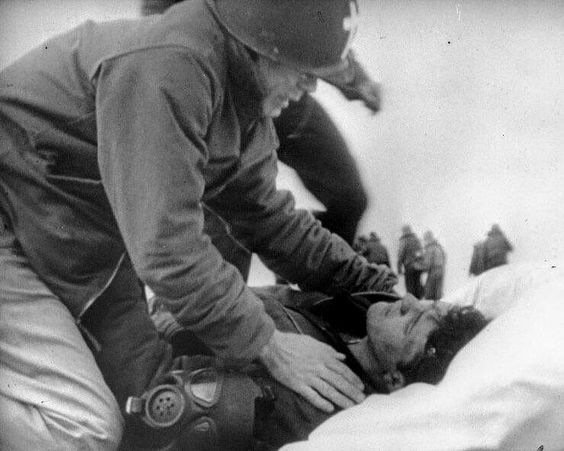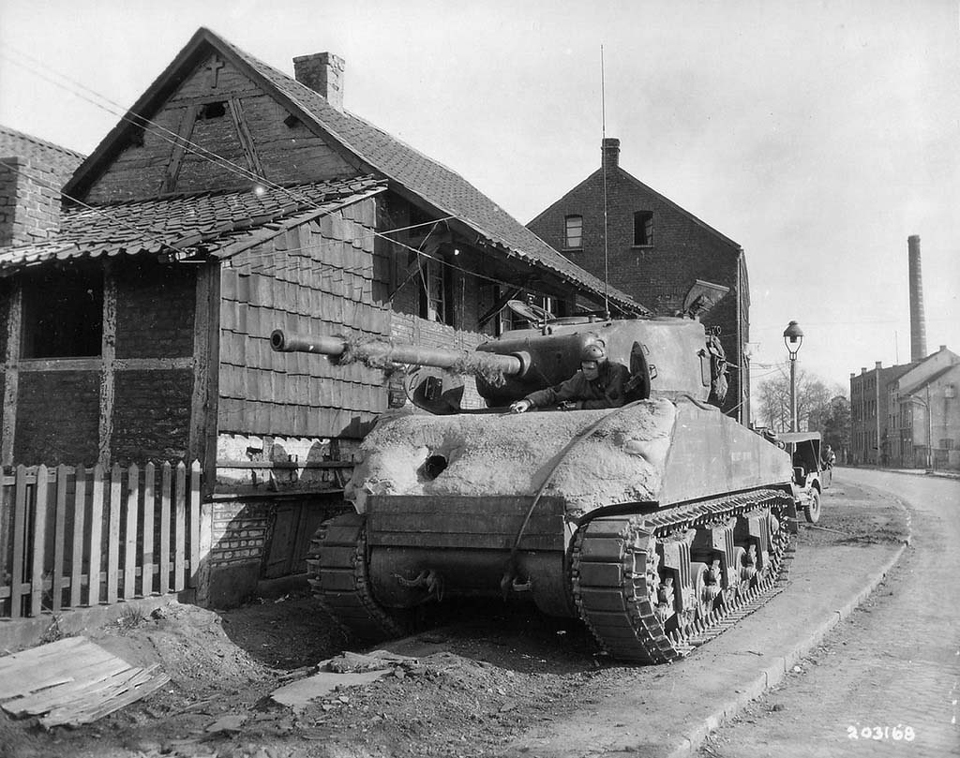Air Operations, CBI
BURMA- 27 10th Air Force P-47s attack troops and supplies at 4 locations directly behind Japanese Army battle lines.
- 24 P-47s support Chinese Army ground forces near Hsipaw.
- 12 459th Fighter Squadron P-38s sweep roads behind the battle areas.
- 5 308th Heavy Bomb Group B-24s attack shipping in the Gulf of Tonkin and the South China Sea.
- During the night 63rd Heavy Bomb Squadron SB-24s attack the White Cloud and Tienho airfields at Canton.
- 4 449th Fighter Squadron P-38s attack motor vehicles between Hoa Binh and Son La.
- 7th Heavy Bomb Group B-24s attack rail lines linking Bangkok with Singapore and Thailand with Malaya.
- 3 B-24s are downed by anti-aircraft fire.
Air Operations, Europe
RAF BOMBER COMMANDDaylight Ops:
- 79 Lancasters of No. 3 Group attack the Consolidation benzol plant at Gelsenkirchen. Smoke and dust from the bombing prevent observation of the results.
- There are no losses.
- 37 Lancasters of No. 5 Group attack the railway viaduct at Arnsberg and the bridge at Vlotho, near Minden. The attack at Arnsberg by No. 617 Squadron using 6 Grand Slams is successful and a 40-foot gap is blown in the viaduct. No. 9 Squadron's attack at Vlotho is not successful.
Minor Ops:
- 34 Mosquitos are sent to Berlin.
- There are no losses.
GERMANY:
- Unable to locate their primaries because of thick clouds, 889 1st and 3rd Air Division B-17s attack various secondary targets--an optics factory at Jena, the city of Plauen, and a motor-transport factory at Zwickau--and numerous targets of opportunity.
- 125 2nd Air Division B-24s attack the Neuberg Airdrome.
- 84 2nd Air Division attack the Leipheim Airdrome.
- 126 Air Division attack an armored-vehicle factory at Baumenheim.
- 6 heavy bombers and 2 of 623 VIII Fighter Command escorts are lost.
GERMANY:
- 9th Air Division bombers attac five rail bridges, two communications cneters, and targets of opportunity.
- P-47s of the XIX TAC's 367th Fighter Group successfully bomb and strafe the headquarters of the German Command-headquarters of the German Command-in-Chief, West (OB West), at Ziegenbert, at very low level through mountainous terrain, a ground haze, and heavy anti-aircraft fire.
- 8th and 9th Air Force fighter pilots down 44 Luftwaffe aircraft over Germany between 0905 and 1715 hours.
AUSTRIA:
- 12th Air Force B-25s attack a bridgeat Muhldorf.
- 12th Air Force B-25s attack bridges and emergency fills at eight locations in northern Italy.
- XXII TAC P-47s attack lines of communication, bridges, and dumps in northern Italy and the Po River valley.
- During the night, XXII TAC A-20s and A-26s attack targets of opportunity in the Po River valley.
AUSTRIA:
- 15th Air Force B-17s and B-24s drop more than 2,000 tons of bombs--their highest one-day total of the war--on a variety of transportation and oil-production targets in and around Vienna.
Air Operations, Japan
- In support of the upcoming invasion of Okinawa, Task Force 58 aircraft attack Japanese Navy fleet units based around Kobe and Kure beginning at 0545. At least 16 Japanese ships are damaged. Among the ships severely damaged are the fleet carriers Amagi and Katsuragi, the light carrier Ryuho, which are all disabled in a single attack by 14 TBMs, 12 SB2Cs, and 19 rocket-equipped Marine and Navy F4Us from the USS Bunker Hill's Fleet Carrier Group 84. The heavy battleship Yamato is also damaged.
- A lone Japanese D4Y 'Judy' dive bomber is able to severely damage the fleet carrier USS Franklin at 0708 hours by setting armed aircraft on her deck afire with two bombs. By the time the fires are brought under control, 772 Marine and Navy personnel have been killed. The USS Wasp is also damaged by a bomb at 0710 with 302 men killed or wounded.
- US Navy carrier-based F6Fs and F4Us down 80 Japanese aircraft over Kyushu, Shikoku, southern Honshu and at sea between 0500 and 1730 hours. VMF-123 carrier-based F4Us down 10 Japanese aircraft north of Kure at 0645 hours. A VMF-221 F4U downs an A6M Zero at sea at 0825. In addition, an estimaged 225 aircraft are destroyed on the ground in various attacks against airfields on Honshu, Shikoku and Kyushu.
- 8 28th Composite Bomb Group B-25s attack canneries in the Kurile Islands.
Air Operations, Philippines
- XIII Bomber Command and 494th Heavy Bomb Group B-24s attack ammunition and supply dumps on Cebu in anticipation of an upcoming invasion.
- V Bomber Command B-24s and V Fighter Command fighter-bombers attack targets in northern Luzon.
Baltic Sea
U-boats are withdrawn from the eastern Baltic.
[Burma
In the British XXXIII Corps sector, the 19th Indian Div follows up its attacks against Fort Dufferin in Mandalay, and a powerful air bombardment succeeds in opening a gap in its walls. Mogok is taken by the British 36th Div.
[Eastern Front
There are renewed attacks by 3rd Belorussian Front against the German forces in East Prussia, especially in the area south of Königsberg. The drive lasts for a week until most of the German forces are eliminated or evacuated. About 38,000 are taken off by the many ships involved including many wounded and refugees.
Soviet troops have recaptured all Hungarian territories lost to the Germans since their counterattack was launched 2 weeks before.
GERMANYThe Soviet 2nd Guards and 47th Armies reach the Oder River at Altdamm, and in Silesia the 4th Tank and 59th Armies have linked up and encircled the Hermann Göring Panzer Corps near Oppeln, also shattering the southern flank of the 17th Army.
HUNGARYThe Soviet 6th Guards Tank Army joins the Vienna Offensive, a move that endangers the 6th SS Panzer Army. Its commander, Sepp Dietrich, orders an immediate withdrawal.[MORE]
[Germany, Home Front
Hitler orders a total scorched earth policy to be put into operation on all fronts. Industrial plants, buildings and food are to be completely destroyed. This is the so-called 'Nero Decree'. Albert Speer, who remains in charge of German industry, does his best to prevent this insane directive from being carried out. He is helped by many army leaders, especially Heinz Guderian, Chief of Staff of the Wehrmacht.
The government cancels all army leaves, orders the registration of all refugees, and commands civilians to inform the police of all army and Labor Corps deserters.
[Germany, Strategy
Hitler issues the decree on Demolitions on Reich Territory in response to the Soviets and Western Allies entering the Reich. It states: 'It is a mistake to think that transport and communication facilities, industrial establishments and supply depots, which have not been destroyed, or have only been temporarily put out of action, can be used again for our own ends when the lost territory has been recovered. The enemy will leave us nothing but scorched earth when he withdraws, without paying the slightest regard to the population. I therefore order: all military transport and communication facitlities, industrial establishments and supply depots, as well as anything else of value within Reich territory, which could in any way be used by the enemy immediately or within the foreseeable future for the prosecution of the war, will be destroyed.' Albert Speer, Armaments Minister, is appalled and will secretly refuse to implement this directive.
Japan
The carrier strikes continue and are mostly sent against Japanese naval bases in the Inland Sea area. Kure is especially singled out. 6 Japanese carriers and 3 battleships are damaged. The kamikaze attacks in reply are very effective. The carriers Franklin (CV-13) and Wasp (CV-18) are both badly damaged and the Enterprise (CV-6) and Essex (CV-9) less so. The 832(772?) dead on Franklin (CV-13) make this the heaviest ever casualty list on any US ship. Lt-Cmdr Joseph T. O'Callahan won the Congressional Medal of Honor for heroism aboard the carrier Franklin (CV-13). He is the first naval chaplain ever to be so honored. The Franklin (CV-13) is able to make the 12,000-mile voyage to the Brooklyn Navy Yard for repairs.
[Pacific
- The last surviving ship of a 21-vessel Japanese convoy is sunk off Singapore. The tanker Sarawak Maru ends up like the others, picked off one by one over a ten-week period as the convoy attempted to bring supplies from Japan to forces in southeast Asia. Some were sunk in daylight attacks by carrier planes and in nighttime attacks by submarines in the China seas; others were hit by mines strewn along their path in the Singapore Strait; eventually all were lost, testament to the effectiveness of the Allied blockade.
- The Japanese river gunboat Suma hits an army mine and sinks off Shanghai, China.
- The US submarine Balao (SS-285) attacks a Japanese convoy off the Yangtze estuary sinking the troopship Hakozaki Maru (10,413t) and damaging the transport Tatsuharu Maru about 90 miles north-northwest of Shanghai. Balao also sinks the merchant fishing vessels No.1 Katsura Maru, No.1 Eiho Maru and No.2 Eiho Maru in this encounter.
Philippines
On Luzon in the US I Corps sector, the 33rd Div occupies the town of Bauang, with its bridge, south of San Fernando. The offensive against the Shimbu line, east of Manila, continues.
[Western Front
In the US 3rd Army sector Koblenz is taken by units of the 87th Div, VIII Corps. The 90th Div, XII Corps, launches its offensive across the Nahe near Mainz, while the 4th Arm Div makes rapid progress to reach Wendelsheim and Schimsheim. South of the Nahe River the 11th Arm Div breaks through the last defenses of the German 7th Army and starts to pursue the enemy on the east bank of the Rhine. The 76th Div extends its bridgehead across the Moselle so as to allow the engineers to throw a bridge over the Mühlheim. The XX Corps advances rapidly toward the Rhine; units of the 10th Arm Div reach the neighborhood of Kaiserslautern, the 80th Div takes Kusel and St Wendel, and the 65th adds considerably to the Saarlautern bridgehead.
In the US 7th Army sector the 70th Div, XXI Corps, crosses the Saar in the area of Saarbrücken. The army persists in its offensive against the Siegfried Line; in the area in which the XV Corps is operating the village of Webenheim falls to the 45th Div and Zweibrücken to the 3rd Div, while on the south flank the 36th Div, VI Corps, takes Wissembourg.
[Images from March 19, 1945
|
|
|
|
|
|
|
|
